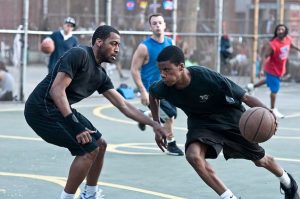Suicide in Basketball
Suicide runs, also known as sprint suicides or conditioning drills, have long been a part of basketball training routines. These drills involve players sprinting back and forth between designated points on the court, gradually increasing the distance with each repetition. While they are often used to improve players’ speed, endurance, and mental toughness, there are concerns about their potential negative impact on athletes’ well-being and the effectiveness of alternative training methods.
The Traditional Approach: What are Suicides in Basketball?
Suicides involve sprinting back and forth between the baseline and free-throw line, half-court line, and far baseline in a timed manner. This drill aims to improve cardiovascular fitness, speed, and agility, but it’s worth considering whether it achieves these goals effectively.
Physical and mental stress
Critics argue that suicide runs place excessive physical and mental stress on players, potentially leading to injuries, burnout, and decreased enjoyment of the sport. Additionally, these drills might not directly translate to game situations, as basketball involves a combination of skills, strategy, and teamwork, which suicide runs do not fully address. Also, read about What is a Dime in Basketball
To create a more balanced and effective training regimen, coaches and trainers could consider the following alternatives:
- Game-Like Drills: Design drills that simulate real game scenarios. Incorporate dribbling, passing, shooting, and defensive movements within the context of a game to enhance players’ skills and decision-making abilities.
- Interval Training: Utilize interval training to improve players’ cardiovascular fitness without subjecting them to extreme stress. This involves alternating periods of high-intensity activity with periods of rest or lower-intensity exercise.
- Functional Strength Training: Focus on building functional strength that directly relates to basketball movements. Incorporate exercises that enhance agility, balance, and stability, which are crucial for on-court performance.
- Skill Development: Dedicate time to individual skill development. Work on shooting accuracy, ball-handling, footwork, and defensive techniques to improve players’ overall performance.
- Teamwork and Strategy: Devote practice time to team-oriented drills that emphasize communication, coordination, and strategic execution. This will help players develop a better understanding of their teammates’ tendencies and improve their overall gameplay.
- Rest and Recovery: Recognize the importance of rest and recovery in preventing injuries and promoting overall well-being. Allow players sufficient time to recover between intense training sessions.
- Sport-Specific Conditioning: Develop conditioning routines that replicate the stop-and-start nature of basketball games. This can include shuttle runs, lateral movements, and short sprints.
- Variety in Training: Keep training sessions diverse and engaging to maintain players’ interest and motivation. Incorporate fun and competitive elements to make training more enjoyable.
Ultimately, the goal should be to prioritize players’ physical health, mental well-being, and long-term development while still enhancing their performance on the basketball court. By shifting away from traditional suicide runs and embracing more holistic training approaches, coaches can help their athletes reach their full potential in a sustainable and effective manner.

The Perceived Benefits of Suicides
Building Stamina and Endurance
Suicides challenge athletes to push their limits and develop more incredible stamina. The repetitive nature of the drill is believed to mimic the demands of a fast-paced basketball game.
Enhancing Mental Toughness
Completing suicides requires mental resilience as athletes confront physical fatigue. Overcoming the mental hurdles in practice can translate to improved focus and determination during games.
The Dark Side of Suicides
Risk of Injuries
The rapid changes in direction during suicides increase the risk of strains, sprains, and more severe injuries, mainly when performed with inadequate warm-up and technique.
Mental and Emotional Impact
Constantly subjecting athletes to gruelling suicides can lead to burnout and a negative association with training. It’s essential to consider the psychological toll it may take.
A Modern Perspective: Effective Alternatives to Suicides
Interval Training
Interval training combines intense bursts of activity with short recovery periods. This approach not only improves cardiovascular fitness but also mimics the stop-and-go nature of basketball.
Agility Drills
Agility drills focus on quick directional changes, enhancing on-court maneuverability and reaction time. These drills can be tailored to replicate game situations more accurately.
Sport-Specific Simulations
Simulating in-game scenarios during training can better prepare athletes for real matches. This approach emphasizes skill development alongside conditioning.
The Power of Recovery
Importance of Rest Days
Rest days are crucial for recovery and preventing overtraining. Allowing the body to recuperate enhances performance and reduces the risk of injuries.
Incorporating Stretching and Flexibility Exercises
Flexibility exercises improve joint mobility and reduce the likelihood of muscle imbalances. Stretching routines can aid in injury prevention and overall athleticism.

Embracing Data and Technology in Training
Tracking Performance Metrics
Using technology to monitor metrics like heart rate, speed, and distance can provide valuable insights into an athlete’s progress and areas for improvement.
Utilizing Wearable Devices
Wearable devices offer real-time data during training, allowing coaches and athletes to adjust intensity and duration based on immediate feedback.
Nutrition’s Role in Conditioning
A well-rounded conditioning program goes hand-in-hand with proper nutrition. Players need the right fuel to perform optimally and recover effectively. Nutrient-rich diets support energy levels, muscle recovery, and overall health.
Hydration: Often Overlooked
Staying hydrated is crucial for performance and recovery. Dehydration can lead to decreased focus, agility, and endurance. Coaches are emphasizing the importance of consistent hydration throughout training.
Recovery: The Missing Piece
Rest and recovery are just as vital as intense training sessions. Proper sleep, active recovery exercises, and techniques like massage therapy contribute to players’ overall well-being and longevity in the sport.
Building Mental Toughness
Conditioning isn’t solely physical; it’s also a mental challenge. Coaches are incorporating strategies to enhance players’ mental toughness, helping them push through fatigue and perform under pressure.
Customized Conditioning Plans
Every player’s body responds differently to training. Tailoring conditioning plans to individual needs ensures that players improve at their own pace while minimizing the risk of injuries.
Evaluating and Adapting Strategies
Conditioning programs should be dynamic and adaptable. Regular evaluation of players’ progress allows coaches to make necessary adjustments and fine-tune the training regimen.

Listening to Players’ Feedback
Player input is invaluable when designing conditioning routines. Coaches are actively involving athletes in the decision-making process to create programs that are effective, engaging, and aligned with their needs.
Conclusion
While suicides have long been a staple in basketball training, it’s essential to evaluate their effectiveness and potential drawbacks. Embracing modern training methods, prioritizing recovery, and utilizing technology can lead to more efficient and safer ways to enhance performance on the court. Remember, the goal is not just to train hard but to train smart. Discover more How Long is Halftime in College Basketball
FAQs
Are suicides the best way to improve cardiovascular fitness?
Suicides have been famous, but alternatives like interval training offer equally effective options with less risk.
Can agility drills replace the benefits of suicides?
Yes, agility drills can enhance agility, reaction time, and direction changes without the high injury risk.
How often should I incorporate recovery days into my training?
Recovery days should be included at least 2-3 times a week, depending on the intensity of your training schedule.
Is technology necessary for effective training?
While not necessary, technology can provide valuable insights and help optimize training routines.
How can mental toughness be improved?
Mental toughness can be developed through various techniques, such as visualization, mindfulness, and controlled breathing.
Alina is a passionate basketball player with a love for the game that knows no bounds. With years of experience on the court, she brings unmatched skill and dedication to her team. Alina’s commitment to excellence both on and off the court sets her apart as a leader and motivator. Whether she’s driving to the basket or encouraging her teammates, Alina’s enthusiasm and sportsmanship shine through. As a valuable member of the basketball team, Alina’s presence elevates the spirit and performance of the entire squad.







